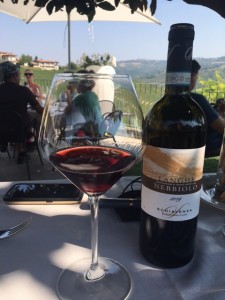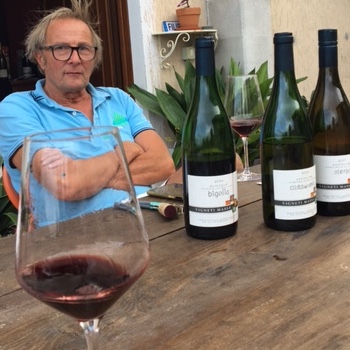Four or five years ago I wrote a column in my series on “Italian Wines by Region” describing the various wines of Piedmont. On our recent trip to Italy, we began our visit with a return to Piedmont, arguably one of if not the best wine regions in Italy.
Any discussion of the best wines in Italy invariably includes the wines from Piedmont. Best known of the red wines from this area are those made from Barbera, Nebbiolo and Dolcetto grapes. In terms of production, Barbera is about 35% of the grape production in Piedmont with Nebbiolo and Dolcetto each about 15%. Barbera is found throughout the region with the other two grapes centered in the Langhe Valley area. Nebbiolo is the sole grape made into Barolo and Barbaresco wine with the difference being the location in the Langhe Valley where the vineyards are located. Both are superb wines which, unfortunately, are generally rather pricey. As I have stated in the past, Langhe Nebbiolo is a cheaper and very good alternative.

A Schiavenzia Nebbiolo. PHOTO: TERRY DUARTE.
There are many excellent Barolos, but two of my favorites are those from Ettore Germano and Schiavenza wineries in Serralunga d’Alba. We visited both wineries and tasted a variety of their offerings. Sergio Germano, owner of Ettore Germano, makes one of the best Rieslings I have ever tasted, Hérzu, but his two Barolos, Prapὸ and Cerretta, are both 95/96 rated in my opinion. Luca Pira at Schiavenza also produces a variety of red wines, highlighted by the winery’s signature Barolo offering, Broglio. We tasted the 2016 Broglio which I though superb and rated a 95/96. Schiavenza also has a trattoria as part of the winery and the beef tips in Barolo are fantastic.
Today there are several other grape varieties that are gaining notoriety. I have written of the resurgence of the Monferrato area with Grignolino and Ruche grapes.
Both of these grapes make excellent wines and are well worth trying. You can see more information in my previous articles on these wines.
As good as the red wines are in Piedmont, there are several white wines that are of the same quality. From the Langhe and Roero Valleys comes the Arneis grape which is made into Langhe or Roero Arneis wine, an excellent dry white wine. This is becoming more popular in the USA and is a great accompaniment to cheese, fish and antipasto. In the eastern part of Piedmont, the Cortese grape produces Gavi, another excellent dry white wine. However, in my opinion the best white wine in Piedmont is produced from the Timorasso grape.
There are now over 50 producers of Timorasso wine, including Gian Paolo Repetto’s Vigneti Repetto, but the king of this wine is its savior, Walter Massa of Vigneti Massa.
The Timorasso grape might have disappeared from wine production entirely had it not been for the efforts of Walter. At one time, Timorasso was being grown on fewer than 10 hectares in all of Italy, half of that on Massa’s land. Walter began a crusade to save the grape. Over many years, he worked to encourage others to grow it, and he continued to grow it in his own vineyard. I have always felt that Timorasso is the best white wine grape in Italy, an opinion I share with wine writer Jancis Robinson.

Walter Massa with his wines. PHOTO: TERRY DUARTE.
We visited with Walter Massa at his winery and tasted a 2011 Derthona Costa del Vento (93/94) and a 2017 Derthona Sterpi (93/94), both Timorasso wines, and a 2010 Bigolla Barbera (95). All were superb and reinforced my belief that Walter Massa is one of the best winemakers in Italy. If you are a white wine lover, you must try Vigneti Massa’s Derthona, available in the U. S.
Piedmont is an Italian region that any wine lover should visit if possible. The scenery is beautiful, the food is delicious, the wine is plentiful and excellent and the people are warm and friendly.




